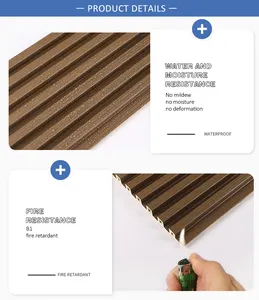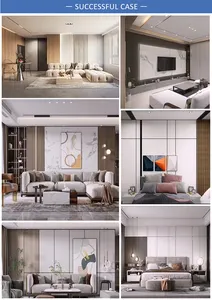
All categories
Featured selections
Trade Assurance
Buyer Central
Help Center
Get the app
Become a supplier

(8546 products available)




















































UPVC house cladding is a construction product made of unplasticized polyvinyl chloride (UPVC) that is used to cover the exterior walls of a house for protective and aesthetic purposes. UPVC cladding is popular for its low maintenance, lightweight, and weather-resistant properties.
UPVC cladding is available in various types, each with a specific design, function, and aesthetic appeal. Here are some of the most common types:
Siding Cladding
UPVC siding cladding is designed to resemble traditional wood siding. It is available in different styles, including clapboard, colonial, and shingles. The clapboard style features horizontal boards, while the colonial style mimics vertical boards. The shingle style, on the other hand, has a design that resembles overlapping wooden shingles. UPVC siding cladding is popular for its classic appearance and low maintenance.
Shiplap Cladding
UPVC shiplap cladding is characterized by its clean lines and overlapping joints. The boards fit together securely, providing a smooth and stylish finish. Shiplap cladding is often used to give a contemporary look to houses. It is also popular for its durability and weather resistance.
Board and Batten Cladding
UPVC board and batten cladding consists of wide boards with narrow battens covering the seams. This type of cladding is traditionally made of wood but UPVC versions are now available. Board and batten cladding is popular for its textured appearance and is commonly used in farmhouse-style houses.
Vertical Cladding
As the name suggests, vertical cladding is installed vertically instead of horizontally like most other types of cladding. It creates a sense of height and is often used for modern and contemporary house designs.
Stone Effect Cladding
This type of cladding is designed to mimic the appearance of stone. It is cast from a mold that has the shape and texture of real stone. UPVC stone effect cladding is available in various styles, such as slate, cobblestone, and river rock. It provides a rustic and natural look to houses.
Architectural Panels
Architectural panels are large sections of UPVC cladding with designs and textures. They are used for decorative purposes and can create a striking visual impact on a house. Architectural panels come in different styles, colors, and finishes, making them versatile for various architectural designs.
Durability and Longevity
The durability of uPVC cladding is one of its key features. Unlike traditional materials like wood, uPVC is not susceptible to rot, warping, or insect damage. This ensures that uPVC cladding maintains its integrity and appearance over the years, providing long-term protection to the building. It is also weather-resistant, capable of withstanding harsh weather conditions such as heavy rain, strong winds, and intense sunlight without deteriorating or fading. This weather resistance is crucial in maintaining the cladding's functionality and aesthetic appeal for many years.
Low Maintenance
Another notable feature of uPVC cladding is its low maintenance requirement. Unlike wood, uPVC does not need to be painted, stained, or sealed regularly to protect it from moisture or UV rays. This significantly reduces the time, effort, and cost associated with maintaining the exterior of the building. Additionally, uPVC cladding is easy to clean. It can be washed with soap and water to remove dirt, mildew, and other contaminants, keeping it looking fresh and new with minimal effort.
Aesthetic Versatility
uPVC cladding comes in various styles, colors, and finishes, allowing homeowners and designers to choose options that complement their architectural design and personal preferences. Whether a sleek modern look or a traditional wood grain finish, there is a uPVC cladding to suit the aesthetic needs. Another important aspect of uPVC cladding's aesthetic versatility is its texture and design options. Some uPVC cladding mimics the texture of natural wood, while others have a smooth or ribbed finish. This variety enables a tailored visual effect to be created.
Insulation Properties
uPVC cladding, particularly when filled with insulation foam, offers excellent thermal insulation. This helps to regulate indoor temperatures, reducing the need for heating and cooling and leading to energy savings. By installing uPVC cladding without insulation, buildings can benefit from reduced energy costs and a more comfortable living environment. Additionally, better insulation reduces a building's carbon footprint, making it a more environmentally friendly construction option.
Moisture Resistance
uPVC's resistance to moisture is a crucial feature. Unlike materials like wood, uPVC does not absorb water, preventing problems like mold, mildew, and rot. This makes it particularly suitable for areas with high humidity or direct water contact, such as coastal regions or the cladding of bathrooms and kitchens. The moisture resistance of uPVC cladding protects not only the material itself but also the underlying structures. By preventing moisture-related issues, uPVC cladding helps ensure the longevity of walls, foundations, and other structural elements.
Environmental Considerations
For environmentally conscious builders and homeowners, the recyclability of uPVC cladding is a significant advantage. Although it is not as widely accepted as other recyclable plastics, efforts are being made to improve the recycling process of uPVC at the end of its life cycle. Some manufacturers also focus on producing uPVC cladding from recycled materials, which further reduces the demand for virgin plastic and lowers the environmental impact of the product's life cycle. Choosing recycled uPVC cladding can contribute to sustainable building practices.
The global demand for uPVC cladding is increasing because of its long lifespan, cost-effectiveness, and easy maintenance. Therefore, cladding manufacturers and suppliers are looking for ways to provide uPVC cladding to different industries and sectors. Here are some common application industries for uPVC cladding.
When purchasing house cladding for resale, buyers will consider various factors before deciding what kind of cladding to buy. They will look at the price point, the quality of the cladding, and the ease of installation, among other things. As a wholesale buyer, it is important to understand these considerations so that appropriate cladding is purchased.
Consider the cladding's technical specifications, especially if buying cladding to be used in coastal areas. UPVC cladding is generally not recommended for use in coastal areas because of the saline air, which can cause long-term damage to the cladding. However, some types of cladding, such as the reinforced ones, can be used in coastal areas. These claddings have UV and saline air-resistant properties.
Some claddings come with warranties that offer protection for specific use cases, such as coastal areas, UV exposure, and extreme weather conditions. These warranties usually indicate the type and duration of the protection offered and should be reviewed before buying in bulk.
The finish and color of the cladding are also important considerations. Cladding is available in various finishes, such as wood grain, smooth, and metallic. It also comes in various colors, and some types of cladding are available in white, which can be used as a base color to create custom colors.
Although UPVC cladding does not require much maintenance, it is important to review the manufacturer's recommended cleaning procedure to ensure that it stays in good condition.
Finally, the installation instructions should be reviewed to determine the type of UPVC cladding joints and fasteners used for installation. Some types of cladding, such as interlocking ones, are easy to install and do not require special tools or techniques.
Q: What does cladding a house with UPVC involve?
A: Putting a skin or layer on the outside of a house made of UPVC is called cladding. This is done to protect the house from weather elements, improve insulation, and give it a certain look.
Q: How long does a house take to be clad?
A: The time a house can take to be clad wholly depends on the size of the house and the type of cladding used. If cladding using UPVC, it is a faster process than traditional ones since no painting is required, and it is lighter and easier to install. Cladding a small house can take a few days, while a bigger one can take weeks.
Q: Do cladded houses require maintenance?
A: Cladded houses require minimal maintenance. This is because UPVC is an unbending material that does not rot or rust, and it is also fire resistant. However, to maintain its look over the years, it requires occasional washing.
Q: Is cladding a house a good idea?
A: Yes, cladding helps enhance the appearance of the house, improve insulation, and protect the structural integrity of the house. It also requires minimal maintenance.
Q: Is UPVC good for cladding?
A: UPVC is a preferred material for cladding since it is lightweight, durable, and strong. It also has good thermal insulation, improves the energy efficiency of the house, and is affordable. Additionally, it is waterproof and resistant to rust and corrosion.